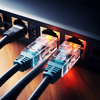
What happens if you plug in two Ethernet cables into your computer at once?
January 25, 2024
If you plug in two Ethernet cables into your computer simultaneously, the behavior will depend on the network configuration and the specific capabilities of your computer's network interface controller (NIC) or motherboard. Here are several scenarios that may occur:

Network Bonding or Link Aggregation: - Some advanced network configurations, especially in enterprise environments or on servers, support a feature known as network bonding or link aggregation. In this scenario, both Ethernet connections are used simultaneously to increase bandwidth and provide redundancy. However, this requires support from both the computer's NIC and the network infrastructure.
Automatic Failover: - Some systems are configured to use one Ethernet connection as the primary link, with the second connection serving as a backup or for failover purposes. If the primary connection fails, the system can automatically switch to the secondary connection.
Network Bridge: - In certain situations, having Two Active Ethernet Connections may lead to unintended consequences, such as network loops or conflicts. This is more common when attempting to bridge two networks using the same computer, which could create network instability.
Manual Configuration: - Some operating systems allow users to manually configure multiple network interfaces. In this case, you might be able to assign different purposes to each connection, such as using one for internet access and the other for a local network.
Network Confusion or Inactivity: - In many consumer-level setups, plugging in two Ethernet cables without specific configurations may lead to network confusion or inactivity. The computer may not automatically know how to use both connections simultaneously, and it may prioritize one over the other.
IP Address Conflicts: - If both Ethernet connections are configured to obtain an IP address automatically (using DHCP) and are connected to the same network, there is a potential for IP address conflicts. Each device on a network should have a unique IP address to avoid communication issues.

In practical terms, if you're using a standard home or office setup, plugging in two Ethernet cables without any specific configuration is unlikely to result in improved network performance. It may even lead to network issues or inactivity. To leverage the benefits of multiple Ethernet connections, such as increased bandwidth or redundancy, specific configurations and support from both the hardware and network infrastructure are typically required.


